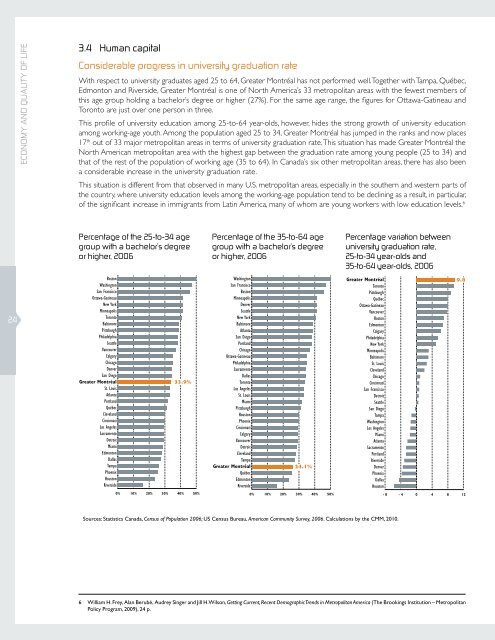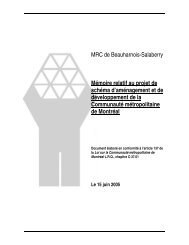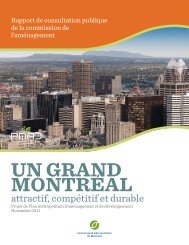Portrait of the Greater Montréal, 2010 edition - Communauté ...
Portrait of the Greater Montréal, 2010 edition - Communauté ...
Portrait of the Greater Montréal, 2010 edition - Communauté ...
You also want an ePaper? Increase the reach of your titles
YUMPU automatically turns print PDFs into web optimized ePapers that Google loves.
ECONOMY AND QUALITY OF LIFe3.4 Human capitalConsiderable progress in university graduation rateWith respect to university graduates aged 25 to 64, <strong>Greater</strong> Montréal has not performed well. Toge<strong>the</strong>r with Tampa, Québec,Edmonton and Riverside, <strong>Greater</strong> Montréal is one <strong>of</strong> North America’s 33 metropolitan areas with <strong>the</strong> fewest members <strong>of</strong>this age group holding a bachelor’s degree or higher (27%). For <strong>the</strong> same age range, <strong>the</strong> figures for Ottawa-Gatineau andToronto are just over one person in three.This pr<strong>of</strong>ile <strong>of</strong> university education among 25-to-64 year-olds, however, hides <strong>the</strong> strong growth <strong>of</strong> university educationamong working-age youth. Among <strong>the</strong> population aged 25 to 34, <strong>Greater</strong> Montréal has jumped in <strong>the</strong> ranks and now places17 th out <strong>of</strong> 33 major metropolitan areas in terms <strong>of</strong> university graduation rate. This situation has made <strong>Greater</strong> Montréal <strong>the</strong>North American metropolitan area with <strong>the</strong> highest gap between <strong>the</strong> graduation rate among young people (25 to 34) andthat <strong>of</strong> <strong>the</strong> rest <strong>of</strong> <strong>the</strong> population <strong>of</strong> working age (35 to 64). In Canada’s six o<strong>the</strong>r metropolitan areas, <strong>the</strong>re has also beena considerable increase in <strong>the</strong> university graduation rate.This situation is different from that observed in many U.S. metropolitan areas, especially in <strong>the</strong> sou<strong>the</strong>rn and western parts <strong>of</strong><strong>the</strong> country, where university education levels among <strong>the</strong> working-age population tend to be declining as a result, in particular,<strong>of</strong> <strong>the</strong> significant increase in immigrants from Latin America, many <strong>of</strong> whom are young workers with low education levels. 6Percentage <strong>of</strong> <strong>the</strong> 25-to-34 agegroup with a bachelor’s degreeor higher, 2006Percentage <strong>of</strong> <strong>the</strong> 35-to-64 agegroup with a bachelor’s degreeor higher, 2006Percentage variation betweenuniversity graduation rate,25-to-34 year-olds and35-to-64 year-olds, 200624BostonWashingtonSan FranciscoOttawa-GatineauNew YorkMinneapolisTorontoBaltimorePittsburghPhiladelphiaSeattleVancouverCalgaryChicagoDenverSan Diego<strong>Greater</strong> MontréalSt. LouisAtlantaPortlandQuébecClevelandCincinnatiLos AngelesSacramentoDetroitMiamiEdmontonDallasTampaPhoenixHoustonRiverside33.9%WashingtonSan FranciscoBostonMinneapolisDenverSeattleNew YorkBaltimoreAtlantaSan DiegoPortlandChicagoOttawa-GatineauPhiladelphiaSacramentoDallasTorontoLos AngelesSt. LouisMiamiPittsburghHoustonPhoenixCincinnatiCalgaryVancouverDetroitClevelandTampa<strong>Greater</strong> MontréalQuébecEdmontonRiverside24.1%<strong>Greater</strong> Montréal 9.8TorontoPittsburghQuébecOttawa-GatineauVancouverBostonEdmontonCalgaryPhiladelphiaNew YorkMinneapolisBaltimoreSt. LouisClevelandChicagoCincinnatiSan FranciscoDetroitSeattleSan DiegoTampaWashingtonLos AngelesMiamiAtlantaSacramentoPortlandRiversideDenverPhoenixDallasHouston0% 10% 20% 30% 40% 50%0% 10% 20% 30% 40% 50%- 8 - 4 0 4 8 12Sources: Statistics Canada, Census <strong>of</strong> Population 2006; US Census Bureau, American Community Survey, 2006. Calculations by <strong>the</strong> CMM, <strong>2010</strong>.6 William H. Frey, Alan Berubé, Audrey Singer and Jill H. Wilson, Getting Current, Recent Demographic Trends in Metropolitan America (The Brookings Institution – MetropolitanPolicy Program, 2009), 24 p.
















